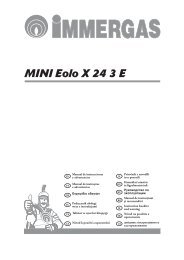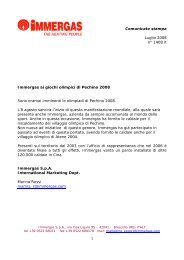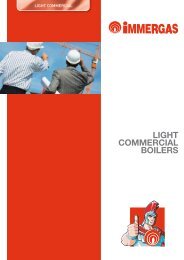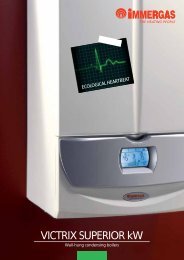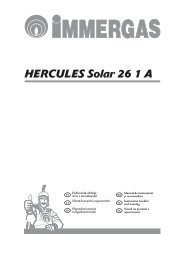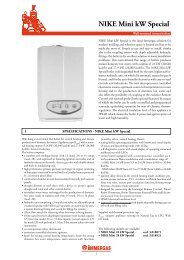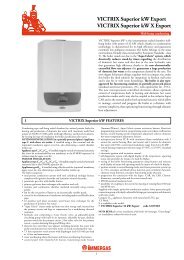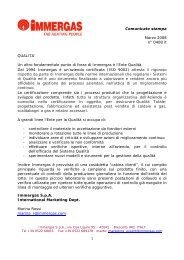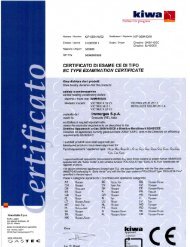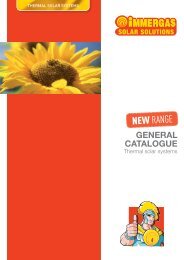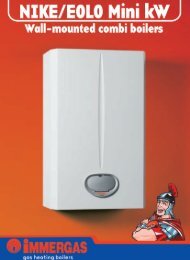MINI Nike 24 3 E - Immergas
MINI Nike 24 3 E - Immergas
MINI Nike 24 3 E - Immergas
You also want an ePaper? Increase the reach of your titles
YUMPU automatically turns print PDFs into web optimized ePapers that Google loves.
3.2 WIRING DIAGRAM.<br />
4<br />
5<br />
3<br />
6<br />
Key:<br />
B1 - Flow probe<br />
B2 - Domestic hot water probe<br />
B4 - External probe<br />
CAR V2 - Comando Amico Remoto remote<br />
control Version 2 (optional)<br />
DS1 - Display<br />
E3 - Ignition and detection electrodes<br />
E4 - Safety thermostat<br />
E6 - Flue safety thermostat<br />
F1 - Phase fuse<br />
M1 - Boiler pump<br />
The boiler is designed for application of a room<br />
thermostat (S20), an On/Off room chronothermostat,<br />
a program timer or a Comando Amico<br />
Remoto remote control V2 (CAR V2 ). Connect<br />
to clamps 40 - 41 eliminating the jumper X40,<br />
paying attention not to invert the polarity if the<br />
CAR V2 is installed.<br />
The connector X8 is used for the connection<br />
of the Virgilio Palmtop in the microprocessor<br />
software updating operation.<br />
3.3 TROUBLESHOOTING.<br />
N.B.: Maintenance must be carried out by a<br />
qualified technician (e.g. <strong>Immergas</strong> Technical<br />
After-Sales Assistance Service).<br />
- Smell of gas. Caused by leakage from gas circuit<br />
pipelines. Check sealing efficiency of gas intake<br />
circuit.<br />
- Irregular combustion (red or yellow flame).<br />
When the burner is dirty or the boiler lamellar<br />
pack is blocked. Clean the burner or the boiler<br />
lamellar pack.<br />
4<br />
5<br />
2<br />
4<br />
5<br />
8<br />
9<br />
4<br />
7<br />
5<br />
M30 - Three-way valve<br />
S2 - Selector switch functioning<br />
S3 - Reset block key<br />
S4 - Domestic hot water flow switch<br />
S5 - System pressure switch<br />
S20 - Room thermostat (optional)<br />
S21 - Domestic hot water temperature<br />
increase key<br />
S22 - Domestic hot water temperature<br />
decrease key<br />
S23 - Heating temperature increase key<br />
S<strong>24</strong> - Heating temperature reduce key<br />
- Frequent interventions of the over heating<br />
safety thermostat. It can depend on the lack<br />
of water in the boiler, little water circulation<br />
in the system or blocked pump. Check on the<br />
manometer that the system pressure is within<br />
established limits. Check that the radiator<br />
valves are not closed and also the functionality<br />
of the pump.<br />
- The boiler produces condensate. This can be<br />
caused by obstructions of the chimney or flues<br />
with height or section not proportioned to the<br />
boiler. It can also be determined by functioning<br />
at boiler temperatures that are excessively<br />
low. In this case, make the boiler run at higher<br />
temperatures.<br />
- Frequent interventions of the flue safety thermostat<br />
This can be caused by obstructions in<br />
the flue gas circuit. Check the flue. The flue<br />
may be obstructed or by height or section<br />
not suitable for the boiler. Ventilation may be<br />
insufficient (see room ventilation point).<br />
1<br />
7<br />
7<br />
10<br />
10<br />
11<br />
11<br />
12<br />
12<br />
7<br />
7<br />
13<br />
13<br />
10<br />
10<br />
T1 - Low voltage feeder<br />
T2 - Switch-on transformer<br />
U1 - Rectifier inside the gas valve<br />
connector (Only available on<br />
Honeywell gas valves)<br />
X40 - Room thermostat jumper<br />
Y1 - Gas valve<br />
Y2 - Gas valve modulator<br />
1 - User interface<br />
2 - N.B.: The user interface is on<br />
the welding side of the boiler<br />
board<br />
3 - 230 Vac 50Hz power supply<br />
4 - Blue<br />
5 - Brown<br />
6 - Yellow/Green<br />
7 - Black<br />
8 - (DHW)<br />
9 - (central heating)<br />
10 - Grey<br />
11 - White<br />
12 - Red<br />
13 - Green<br />
Fig. 3-2<br />
- Presence of air in the system. Check opening of<br />
the hood of the special air vent valve (Fig. 1-10).<br />
Make sure the system pressure and expansion<br />
vessel pre-charge values are within the set<br />
limits; the pre-charge value for the expansion<br />
vessel must be 1.0 bar, and system pressure<br />
between 1 and 1.2 bar.<br />
- Ignition block and Chimney block. (See par.<br />
2.6 and 1.3 (electric connection).<br />
ES<br />
PL<br />
TR<br />
CZ<br />
SI<br />
HU<br />
RU<br />
RO<br />
IE<br />
SK<br />
UA<br />
153



